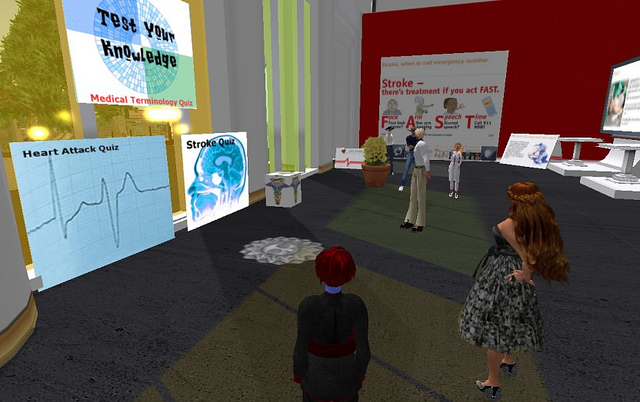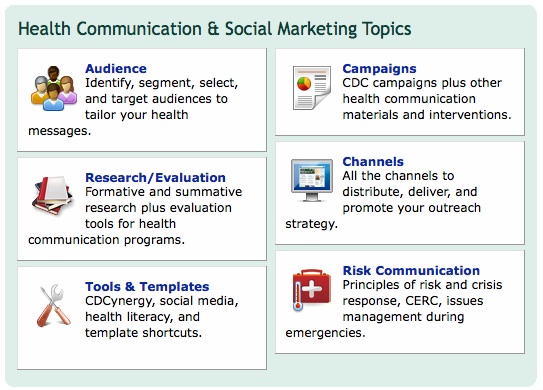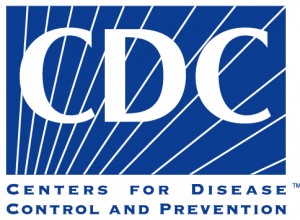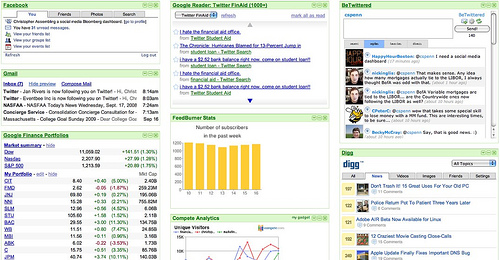
Where do you turn for the latest research on the impact and influence of social media?
This edition of the Health Care Social Media Review (HCSM) provides the latest research your fellow colleagues are studying by highlighting social media research and related resources. Whether you’re talking with your stakeholders, board, manager, customer, or colleague, being well-versed in the research equips you with the evidence and theory needed to optimize your impact.
I have yet to attend a social media workshop or presentation where someone doesn’t ask about resources relatesd to social media research. (And thank goodness, right? We need to stay curious.) A number of people want research to help them understand the pros and cons of social media and translate how that knowledge applies to their mission. Here’s what our peers had to share this week:
Rich Resources
- Pew Internet & American Life Project: This is the main go-to for many, given Pew’s look into at the impact and use of technology across demographics. Did you see their June 5 report sharing that 56% of Americans own a smartphone? Their May 21, 2013 report may also be applicable to you as it focused on teens, social media and how they view privacy.
- DigiHealth Pulse: Enskeptos is newer to the scene but offers insights from their ongoing tracking study of digital health consumers. The study looks at 39 health topics and 11 different health behaviors to help us better understand how active digital health consumers consume, perceive and react to online health information.
- Journal of New Communications Research: The Society for New Communications Research (SNCR) is always a must-watch as they support and fund research. Both Fard Johmar (of Enskeptos) and Craig Lefebvre have participated in SNCR, helping bring health care social media research to bear.
- CDC’s Health Communication Digest: Looking for the latest peer-reviewed literature? CDC offers up its Health Communication Digest, highlighting a findings of note, many of which relate to health care social media.
- PWC, Comscore, eMarketer and Nielsen A number of organizations offer up research and studies that can help further guide our work. For example, many of you may recall PWC’s report, “Social Media ‘Likes’ Health Care”.
- #SMMStandards: If you haven’t bookmarked this group, you’ll want to as the group is working across industries to develop standards in social media measurement .
Laying the Groundwork
This topic for this edition was inspired by some of my own social media research activities. Craig Lefebvre and I recently published a review of the research and evidence for the use of social networking sites (SNS) to improve cardiovascular health in the April 30, 2013 edition of Circulation, a journal of the American Heart Association. The paper, titled Digital Social Networks and Health, also offers guidance on the potential of creating social health experiences while also proposing a research agenda for better understanding the use of social media in health.
Not shortly thereafter, Damon Centola of MIT published a follow-up article, titled “Social Media and the Science of Health Behavior“, also in Circulation. Centola’s article is a great read for those looking to understand and explore new research areas thanks to the opportunities social media affords. He also shares a case study from the Healthy Lifestyles Network that helps drive home the potential of what can be when you combine the power of social networks with social media–a key theme we share.
Diving In
Here are some additional research nuggets submitted to the review:
- The Cancer Conversation Grows and Narrows: Greg Matthews shares insights from The MDigitaLife Social Oncology Project 2013, which tracked more than 16 million cancer-related conversations. He shares: “…increasingly, there isn’t just one cancer conversation – there are distinct and recognizable conversations happening now about dozens of different cancer varieties – each with its own participants, preferred channels, media coverage and physician influencers.” Having done some research into the HIV conversation online, I can share that this statement also applies to the evolved HIV discussion online and makes me wonder what other health topics and diseases are becoming more sophisticated and what that means for our work.
- Here’s a Conundrum: Hispanics are some of the greatest users of mobile and social media technologies. And despite all our work in health care social media, over half of Latinos don’t know key aspects of the new health care law. This is our fail. At the same time, it’s a great opportunity for change. Any takers?
- Twitter and Vaccine Information = A Good Mix: According to a new study, Twitter was found to be a popular and reliable source for vaccine information. Of note, researchers found that over the more than 2k tweets analyzed, 54% conveyed a neutral position on vaccinations.
- Is Social Media Helping or Hurting? Researchers in Canada are looking into the impact of social networks and social networking sites on mental health, putting a large focus on Facebook. I’ve written before on conflicting findings regarding Facebook’s impact on our health, so I can’t wait until the findings of this study are released.
- People Want Online Video, but Aren’t Sure How to Get It or Measure Its Impact: Given increasing interest in online video and YouTube’s latest design update, you may be interested in the latest report, “Into Focus: Benchmarks for Nonprofit Video and a Guide for Creators“. This is the first report of its kind and was compiled by See3 and Edelman in collaboration with YouTube’s Nonprofit Assistance Program.
- Text4Baby Works, Still: A new report came out finding that the Text4Baby program is beneficial to women and moms. This may also be one reason why the program has expanded its offerings into video. In reviewing digital health solutions, email and/or text reminders over and over are found to be effective in individual pilots and projects. Hopefully, this added research will support similar types of efforts. Email may not be as “sexy” as social media, but it is effective.
Coming Soon
While the body of research grows, some organizations are joining the effort. One such organization is the Human Factors group which is hosting a social meida research competition with a $10,000 prize purse. What about you – do you have any social media research activities planned for 2013?
Thank you again for your contributions to this edition. Health Care Social Media Review has information about the next edition’s host and instructions on how to submit your posts for review in future editions.
]]>
photo by Robin M. Ashford
We are all patients. Yet only 10% of adults have the knowledge and skills needed to understand important information about their health (yikes!).
This edition of the HCSM Review celebrates October’s Health Literacy Month by exploring how this issue impacts online health information and the use of health care social media.
Health Literacy Coming of Age
What’s in a name? Social marketing isn’t the only one experiencing teenage angst in defining itself. Scholars recently conducted a recent review of 17 definitions of health literacy and developed a new definition that “captures the essence” of these definitions found in the literature. Can you believe there were 17 different definitions to begin with?
Taking steps forward. Building upon this review, my RTI colleagues published the “Health Literacy Skills Framework” which includes “information seeking & eHealth” as a critical skill set needed to navigate today’s health information. They also share that “the absence of a common definition and understanding of health literacy may have slowed the field’s progress in developing measures and conducting solid methodological research.”
Recommended reading. Andre Blackman shared this wonderful gem: the recently published eHEALS Health Literacy Scale. The eHEALS is an 8-item measure of eHealth literacy developed to measure consumers’ combined knowledge, comfort, and perceived skills at finding, evaluating, and applying electronic health information to health problems. Also shared was the recommended read of the book Understanding Digital Literacies: A Practical Introduction.
Patient demands. A recent Harris Interactive study found that patients want more access to Web-based health services. Emily Zeigenfuse expands on this in her post “The Disconnect Between Patient Expectations and Physician Actions.” She discusses the role of communication and how social technologies can help providers more easily transition from acute care to preventative care.
The belle of the ball. Healthcare-related tweets have increased by 51% in 2012! Kristi Eells highlights this and other factoids shared at the recent Health 2.0 conference. From her review of findings, you can’t help but see 1) the increased value and demand for health care social media 2) and the need to address health and digital literacy in our use of these tools.
The Fun Stuff
Hacking for health. Over the weekend, Communicate Health hosted their first Health Literacy Hackathon. They highlight the results on their blog. You can even use the winner’s end product, Carrots/Stick. Carrot/Stick is a phone-based service that utilizes family and social support to empower smokers to quit. Nice work!
Everyone loves a good inforgraphic. Also of note is Communicate Health’s health literacy infographic, We are the 90%! A sneak peak is provided below. Speaking of infographics, Trish Broome explores how infographics can be a health education tool sharing her experience in developing an infographic to communicate flu prevention messages.
Let’s get chatty. healthfinder.gov is hosting its 3rd annual Health Literacy Twitter chat. Using the hashtag #healthlit, join @healthfinder, @HHS_DrKoh, @AHRQNews, @HealthLitMo and others to discuss IOM’s recent paper on the 10 Attributes of Health Literate Health Care Organizations. Explore the question: How can organizations help people navigate health services more easily?
Imagineering the future library. With Pew’s recent presentation on The Rise of eReading, I couldn’t help but note Lucy Bernholz’ post on the evolving role of the community library. Knowing the role of libraries in health education, innovative models can and are being developed.
*****
Thank you for all of your contributions to this edition. HealthCare SocialMedia Review has information about the next edition’s host and instructions on how to submit your posts for review in future editions.
]]> You may have noticed a fun new badge on the bottom right of SocialButterfly. This badge links to CDC’s recently launched “Gateway to Health Communication and Social Marketing.” This gateway acts as a feeding ground for those looking for resources, tools, templates, case studies and answers to all their questions about social marketing and more. At the very least, it’s a starting point.
You may have noticed a fun new badge on the bottom right of SocialButterfly. This badge links to CDC’s recently launched “Gateway to Health Communication and Social Marketing.” This gateway acts as a feeding ground for those looking for resources, tools, templates, case studies and answers to all their questions about social marketing and more. At the very least, it’s a starting point.
Part of this new land is a new CDC Blog–and guess what–you can be the one to name it! Though, CDC isn’t the only one with a new blog on the market. Ogilvy PR recently launched their Social Marketing ExChange as well (and started an office in Atlanta–as did AED…). I know I’m not alone when I jump up and down at these new steps in bringing social marketing to bear. Maybe one day, with organizations with this type of umph and leadership behind us, social marketing will be a household name. Or, at the least, recognize-able as a profession.
So, what would you name the new CDC blog? Here are some thoughts off the top of my head:
- Push and Pull: Not only does social marketing combine a number push and pull strategies and tactics, but the blog can also serve as a forum for health communicators and social marketeers to debate, discuss, share and “push and pull” insight and information amongst one another.
- Influence Health: This is action oriented and speaks to behavior change, but also to the impact and influence social marketing and health communications can have. Influence health could be interchanged with a name like Impact Health or Improve Health as well.
- The Power of Health. This is what we believe in–if we improve health, we improve quality of life, and therein, increase happiness (in sum).
- Speaking of Health. I didn’t come up with this…someone who already commented over at CDC did, but I like it too. I feel it’s catchy, frames the conversation for health, is action-oriented and can umbrella a number of topics.
What do you think? What would you name it and why?
PS: For a listing of additional blogs, UNC’s School of Public Health has a strong listing of health blogs, and I have a long list of social marketing specific blogs as well.
]]>
Buzz has been building for a while now as delegates, organizers and presenters make their final preparations for next week’s National Conference on Health Communication, Marketing and Media. Hosted by the CDC’s National Center for Health Marketing and the Office in Enterprise Communications, the conference is packed with discussion about health marketing, health disparities, new frontiers in technology, and collaboration.
iQ Solutions’ own VP of Health Communications, Jennifer Isenberg Blacker, will also be presenting on behalf of the National Institute on Drug Abuse about the use of new technologies to engage youth. Senior VP of Communications and Social Marketing, Kim Callinan, and myself will also be there to cheer her on and gain insights from other presenters, as well as share in community with other health evangelists.
As the iQ team preps for our journey down to Atlanta, I’ve identified five ways to prepare for this year’s CDC Conference:
1. Network. Nedra Weinreich has set up a community on NING, a social network that lets you create your own social community. Already boasting 60+ members, this public platform enables us to network before, during, and after the conference, and is how I learned that the CDC program book was available for download.
2. Follow the conversation. Whether you are signed up for Twitter or not, you can still follow the conversations that are happening there. Using the tool Twitter Search, type in the hashtag “#NCHCMM09” to see what people are saying about the conference. I will also be live-tweeting certain presentations and added insights through IQ Solutions’ new Twitter handle, @iQSolutions.
3. Create your own conference dashboard. If you want to be a real superstar like Chris Brogan or Christopher Penn, you can even create your own conference dashboard using iGoogle, Netvibes, or PageFlakes. The dashboard, Brogan explains, is a one-stop online location “to see the elements you might want to know about at a conference…and you can get a fast scan of a lot of data that might prove useful during the event.” Example information may include adding some Twitter search strings to your dashboard, integrating a local map, local clock, local weather information, and much more. See an example below.

4. Meet-Up and Tweet-Up. They say at conferences that some of the best insights and conversations are those you have with colleagues in the hallways or over a great meal. Don’t miss out on these nuggets of opportunity for sharing. Already, CDC’s Justin Williams has organized a Tweet-up for Wednesday, August 12th from 7:30-10:30pm at STATS. This is one more opportunity to gather and meet with colleagues. Already attending are Craig Lefebvre, Andre Blackman, Susannah Fox and myself. Join us.
5. Study. It’s always good to know what you’re getting yourself into. Thus, I recommend checking out the conference’s Web site, seeing who’s who, as well as downloading and reading through the program book. Studying may be overkill, but as I mentioned earlier, this conference is packed with powerful presentations-so much so, that if you’re like me, you’re going to have to prioritize what you can attend. It’s not possible to see every single presenter, even though you’ll want to! (This is another good reason Tip #2 and Tip #3 come in handy-you can catch what you may be missing during concurrent presentations.)
Your Turn: What other tips might you offer to prep for this year’s conference?
]]>